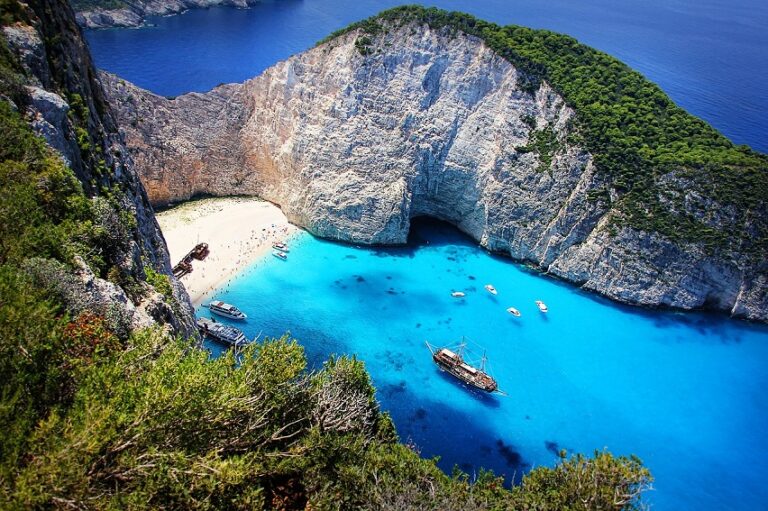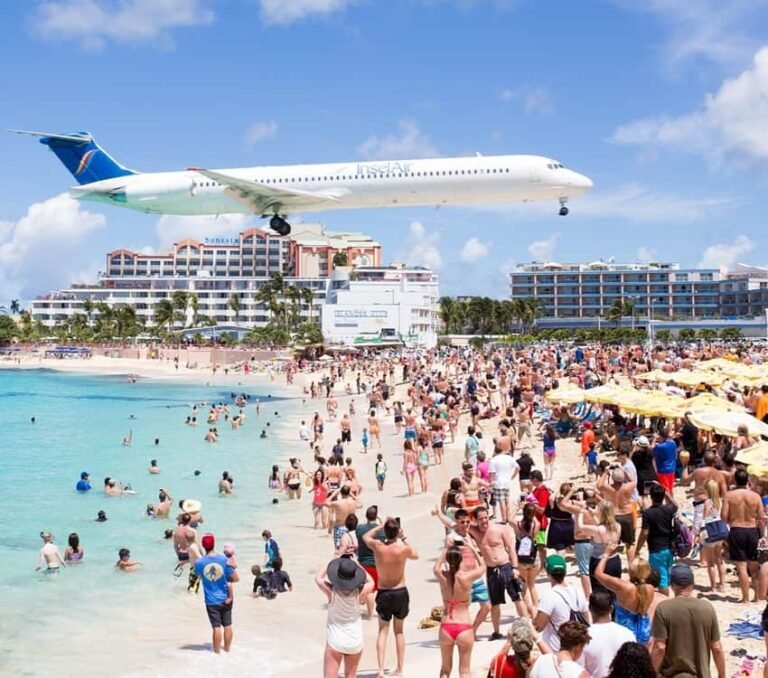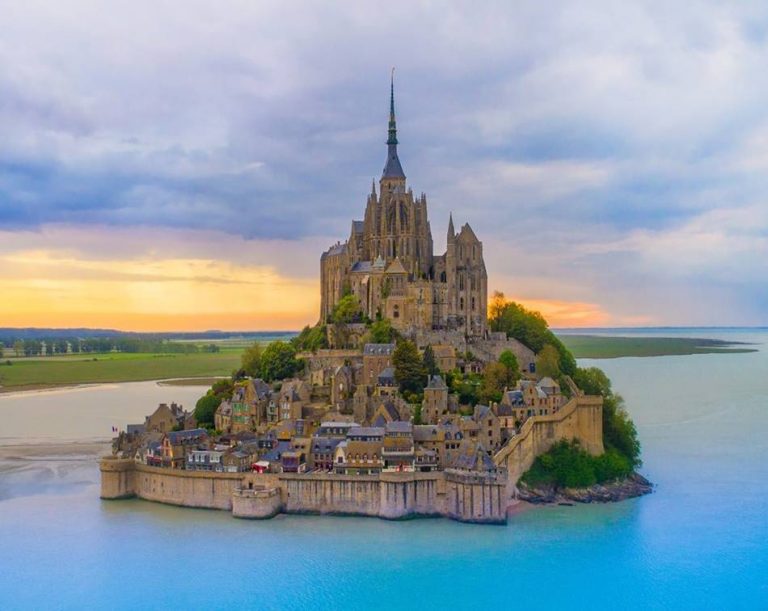Angel falls – World’s Highest Waterfall in Venezuela
Last Updated on 16th October 2025 by admin
Angel falls is known to be one of the most amazing natural wonder of the world, situated in the heart of Venezuela. In 1933, an American aviator known as Jimmie Angel discovered the falls and is named after him. Angel Falls is the highest waterfall in the world and a unique natural wonder which draws tourists from around the world.
Here in this article we are going to explore the history, features and interesting facts of the Angel Falls and also we are going to discuss the conservation and preservation efforts to protect this wonder of nature.
Table of Contents
World’s Highest Waterfall in Venezuela
Angel Falls (Salto Ángel) is the world’s highest or tallest waterfall, it’s a breathtaking wonder of nature that attracts thousands of visitors to Venezuela from around the world. Angel Falls located in Canaima National Park, and this is the second largest national park in Venezuela. The waterfall cascade goes down to 3212 feet (979 meters) at the base from the Auyán-tepui mountain, which is more than half a mile (approx 1 kilometer) and one of the greatest natural wonders of the world.
Most of the water evaporates in the form of fog or moisture before it hits the ground. Angel Falls is a popular tourist attraction of Venezuela and can only be reached by plane or boat. Visitors can take a guided tour to see the falls up close or opt for a helicopter tour to get a bird’s eye view of the entire area.

The Discovery of Angel Falls
Angel Falls were discovered in 1933 by Jimmie Angel who was searching a gold mine. Angel’s plane crashed during his journey and he and his companions had to walk through the jungle to find help. On their way, they came across the waterfall and named it Angel falls in honor of their pilot.
The Height and Features of Angel Falls
Angel Falls is the highest waterfall in the world, and its total height is 979 meters (3,212 feet). The waterfall is made up of a series of drops that span more than 800 meters (2,600 feet) and forms a misty spray.
This world’s tallest waterfall is so huge even it can be visible from miles. Falls water source is fed by the Churun River, which empties into the Carrao River forming an impressive show of the power of nature.
The Surrounding Landscape of Angel Falls
Angel Falls is found in the Canaima National park which is a UNESCO World Heritage site. The park is home to a unique ecosystem, which consists of table mountains, tropical rainforests, and savannahs. Nature around is rich with flora and fauna such as orchids, bromeliads, jaguars, giant armadillo etc. There are also indigenous Pemon peoples in the region who have a strong connection to the area culturally.
Interesting Facts About Angel Falls
In addition to its great height, there are several interesting that make Angel Falls a fascinating place to be visited by the travelers. Here are 5 interesting facts about Angel Falls:
- World’s Tallest Waterfall: Angel Falls is the highest uninterrupted waterfall in the world, it falls approximately 979 meters (3,212 feet) down from the top of Auyán-Tepuí mountain in Venezuela.
- Named After an American Pilot: The waterfall was named after Jimmy Angel, an American pilot who accidentally discovered it in 1933 during a search to locate a gold ore bed.
- Located in a Remote Jungle: Angel Falls is in the Canaima National Park which is a UNESCO World Heritage Site and can only be approached by air or river boat.
- Hidden by Mist: The water is usually sprayed into mist before hitting the ground due to its great height. This brings a magic sight which is filled with clouds and rainbows.
- Known Locally as “Kerepakupai Merú”: This name is translated in Pemon indigenous language, this name means “waterfall of the deepest place,”.
- A Symbol of Venezuela: It is one of the most popular natural landmarks in Venezuela and a major symbol of the country, highlighted in the tourism advertisements and national pride.
- Seasonal Flow Changes: The flow of the waterfall is depends on rainfall. Its greatest strength is in the rainy season between June and December. During dry season the stream may be reduced to a narrow flow.
The Origin of Angel Falls
As you know, Angel falls is the highest waterfall in the world found in Canaima National Park of Venezuela, but how was this beautiful waterfall formed? Let’s find out.
Geological Formation:
The geological history of this highest waterfall started more than 200 million years ago when supercontinent Pangaea existed. A shallow sea covered the area and with time, layers of sandstone and shale were created through sedimentation.
Approximately 70 million years ago, the activity of tectonic forces started to raise the region creating the Guiana Shield, which is a great plateau that occupies the largest part of northern South America. The uplift made the rock layers fracture to make deep canyons, such as the one the Angel Falls flows through.
The Formation of Angel Falls:
The Churun River, which flows into Angel Falls, has its origin at the top of the mountain named Auyan-tepui. The region is well covered with a number of tepuis, which include Auyan-tepui, the largest tepuis which covers an area of more than 700 square kilometers.
The river Churun passes across the top of the Auyan-tepui and then drops 979 meters over the edge, forming Angel Falls. The height of the drop and the mass of water falling on top of the edge cause the falls.
The falls have gradually shifted upstream due to the erosion of the rock by the continuous water flow underneath the falls. Indeed, the falls continue to go upstream at an average rate of approximately one meter per 1,000 years.

How to get to Angel falls Venezuela
It is an adventure in itself to get to this beautiful waterfall, yet well worth the effort. Tourists visiting Angel Falls have the option of various guided tours to the region. Seeing this world’s tallest waterfall is an experience to be once in a lifetime and it is not a surprise that it is also one of the most famous tourist attractions within Venezuela. Visiting here will be a journey that will not be forgotten with breathtaking natural beauty, cultural experiences and a variety of tours and accommodation. If you’re considering visiting Angel Falls, here’s what you need to know.
Getting There:
- By Air: he most convenient and easy mode of access to the Angel Falls would be the flight of Caracas to Ciudad Bolivar and then another smaller aircraft to the Canaima National Park. At that point, tourists can board a boat and ride along the river to the falls.
- By Land: Visitors can also take the bus or the car to Canaima National Park, Ciudad Bolivar in about 10 hours. It is a cheaper alternative that may get exhausting and uncomfortable.
- By Tour: For here you can find various tour companies that provide tours including transportation, lodging and activities. It is a higher cost but could be a hassle free and pleasant experience.
Regardless of how visitors arrive at Angel Falls, they should be ready for humid and highly variable weather conditions in the area. Appropriate clothing, gear, and supplies should follow you on your travels, as well as hire a knowledgeable guide for a safe and memorable experience.
In Canaima, for example, you can take a motorized canoe up the Carrao and Churun Rivers to the base of the falls. The trip will take approximately four hours. You will probably have to stop a few times around some rapids and transfer to smaller canoe crafts to navigate through narrow stretches.
Tour Options:
There are a variety of tour options available for visitors to Angel Falls. Some tours offer day trips to the falls, while others include overnight stays in the park. The most popular tours include a visit to the base of the falls, where you can feel the mist on your face and marvel at the sheer size and power of the falls.
Other tours offer more in-depth experiences, such as trekking through the rainforest, visiting Pemon villages, or exploring other waterfalls in the park. Some tours also offer the opportunity to take a scenic flight over the falls, providing a unique perspective on this natural wonder.
Visitors to Angel Falls can choose from a range of available tours. Some tours offer day trips to the falls and others have a overnight stay at the park included. Likely the most popular tours include a visit to the base of the falls to enjoy the mist in your face and the power of the size of the falls.
Some tours are designed for a more complete experience with trekking through the rainforest, visiting some Pemon villages, or visiting other waterfalls in the park among other things. Some tours may even provide a scenic flight over the falls for a different view of the wonder.
Accommodations:
Within Canaima National Park, several accommodation options exist, from luxurious eco-resorts to rustic lodges. Many lodges are located next to the falls providing breathtaking views of the nearby scenery. However, the options for accommodations may be limited, so it’s recommended to book in advance.
The Best Time to Visit Angel Falls
The best time to visit Angel Falls depends on numerous factors such as weather, water volume, tour availability, and safety issues. Although the rainy season is the most preferred time to visit in order to experience the most spectacular views of the falls, the dry season may also offer a more peaceful and serene experience. With good planning and regard for all the conditions, a journey to Angel Falls will be a memorable experience.

Rainy Season:
The rainy season in Venezuela is from May to November, and it is usually the most favorable time of the year to visit Angel Falls. The falls are at their best during this period when a greater amount of water plunges over the edge. The spray and mist of the falls form a rainbow effect when they are sprayed by the sun’s rays, and it makes for a wonderful photography experience.
Nonetheless, the rainy season does pose difficulties in reaching the falls. Extreme rain may flood the rivers, making it more challenging to reach by boat. Also, flights from and to the falls can be cancelled or delayed due to poor weather conditions.
Dry Season:
The dry season in Venezuela is from December to April, and although the falls are still impressive at this time, the amount of water cascading over the edge is much lower. This can cause the falls to look less spectacular, with a smaller stream of water plunging over the edge.
Yet, travel to the falls may also become simpler during the dry season. Rivers are not as swollen, and it is less probable that flights will be cancelled or rescheduled because of weather conditions. Fewer tourists also flock to the falls during the dry season, making it a more peaceful and quiet time to visit.
Considerations:
When planning a trip to Angel Falls, it’s a good idea to keep in mind other things besides the weather. For example, tour availability can be a consideration because some tours run only at certain times of the year. There may also be limited accommodations, so you want to plan ahead and book your hotel rooms.
Additionally, any travel warning or advisories in the country should also be taken into consideration. Venezuela has faced political and economic instability in the past few years and does have safety issues in certain parts of the country. It is advisable to check on the situation prior to making a trip and precautions should be taken to make it a safe visit as well.
Preserving Angel Falls
The Venezuelan government and indigenous Pemon people take the conservation of the beauty and integrity of Angel Falls very seriously. To conserve the area, the site is restricted to guided tours alone, and tourists are subjected to strict regulations for conduct and conservation. This makes certain that the location is maintained pristine for future generations. In order to maintain this rare and sensitive environment, there are attempts made in order to safeguard the park and its adjacent places.
Conservation Efforts:
The Canaima National Park was created in 1962 and occupies a land area of about 30,000 square kilometers. The park has a wide variety of flora and fauna, including threatened species like the giant otter, jaguar, and harpy eagle. Apart from the falls, the park has other significant natural features like mountains, forests, and rivers.
To maintain this fragile ecosystem, the park is a UNESCO World Heritage site and various conservation measures have been taken. These are:
- Protection of wildlife: Hunting is strictly banned within the park, and measures have been taken to safeguard species under threat. Park guides and rangers also inform visitors of the need to respect and conserve the wildlife and their habitats.
- Sustainable tourism: Tourism is an important source of income for the region, but it has to be managed sustainably. Steps have been taken to restrict the visitor numbers at the falls, and to promote responsible tourism such as the use of biodegradable products and waste reduction.
- Cultural preservation: The park contains a number of indigenous communities, such as the Pemon people. Their cultural practices have been conserved and their economic opportunities encouraged as sustainable activities such as community-based tourism.
Challenges:
In addition to these conservational activities, the park and the falls are subject to many challenges. The park’s biodiversity is threatened by illegal mining and deforestation around the park. Climate change effects may also reach the falls and the ecosystem around them.
In addition, the political and economic instability in Venezuela has made it difficult to allocate resources and support conservation efforts. However, despite these challenges, there are ongoing efforts to protect this unique and important one of the natural wonder.
FAQs
- Where is Angel falls?
Angel Falls is located in Venezuela’s Canaima National Park, in the southeastern region of the country.
- Can we swim in Angel Falls?
No, swimming in the waterfall is not allowed due to the strong currents and dangerous conditions.
- How do you get to Angel Falls?
Visitors can access Angel Falls through a variety of transportation methods, including planes, boats, and hiking.
- What is the best time to visit Angel Falls?
The best time to visit Angel Falls is during the rainy season from May to November when the waterfall is at its most impressive.
- Are there any accommodations near Angel Falls?
Yes, there are several accommodations available near Angel Falls, including hotels, lodges, and campsites.
- Is it safe to travel to Angel Falls?
Yes, as long as visitors take the necessary precautions and follow safety guidelines, traveling to Angel Falls is generally safe.
Angel Falls is a natural wonder that should be on everyone’s bucket list. Its sheer size and beauty make it one of the most famous waterfalls on the planet, and the surrounding rainforest provides visitors with a unique and unforgettable experience. Whether you choose to take a boat tour, a trek, or a helicopter tour, visiting this amazing natural wonder is an experience that you will never forget.






